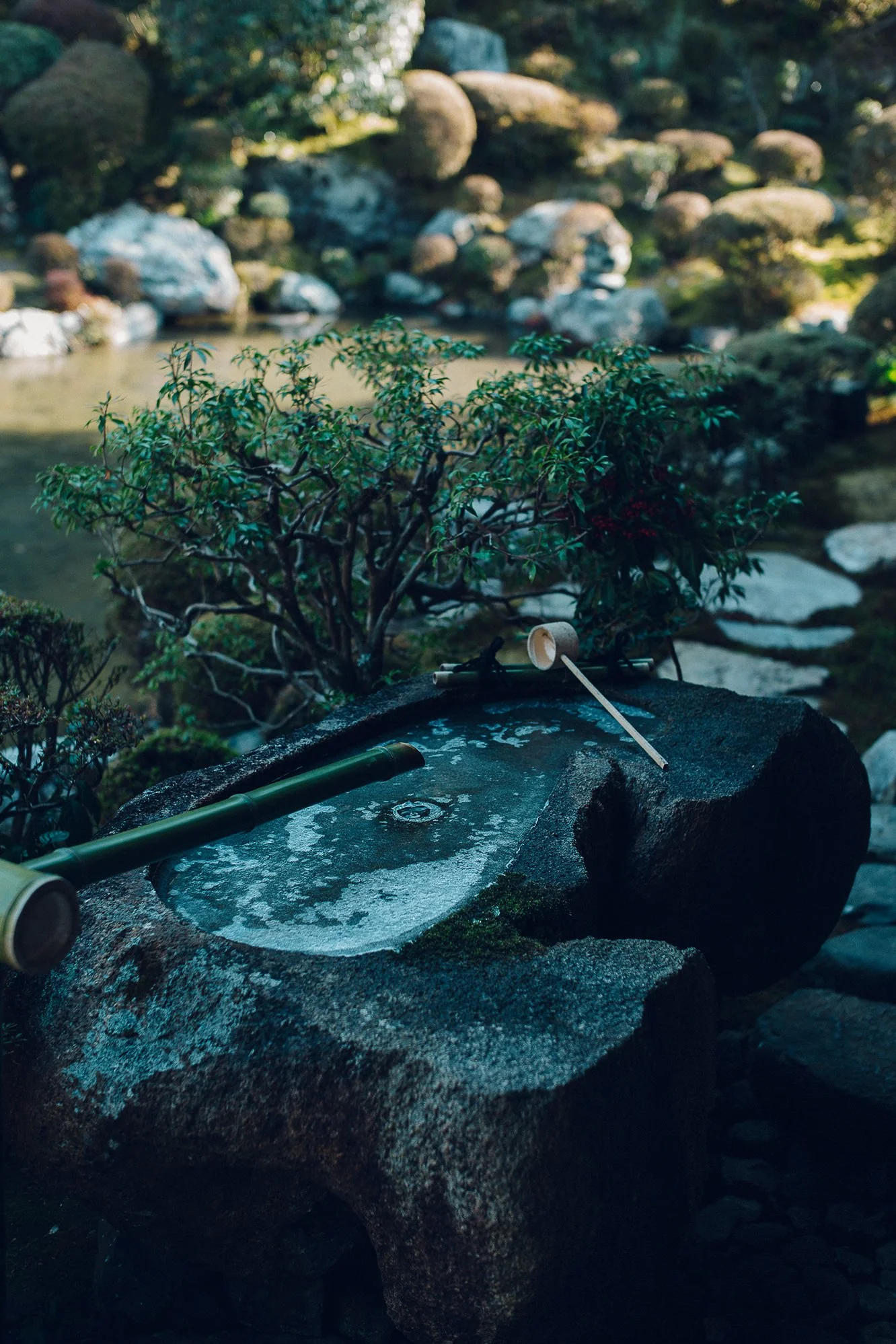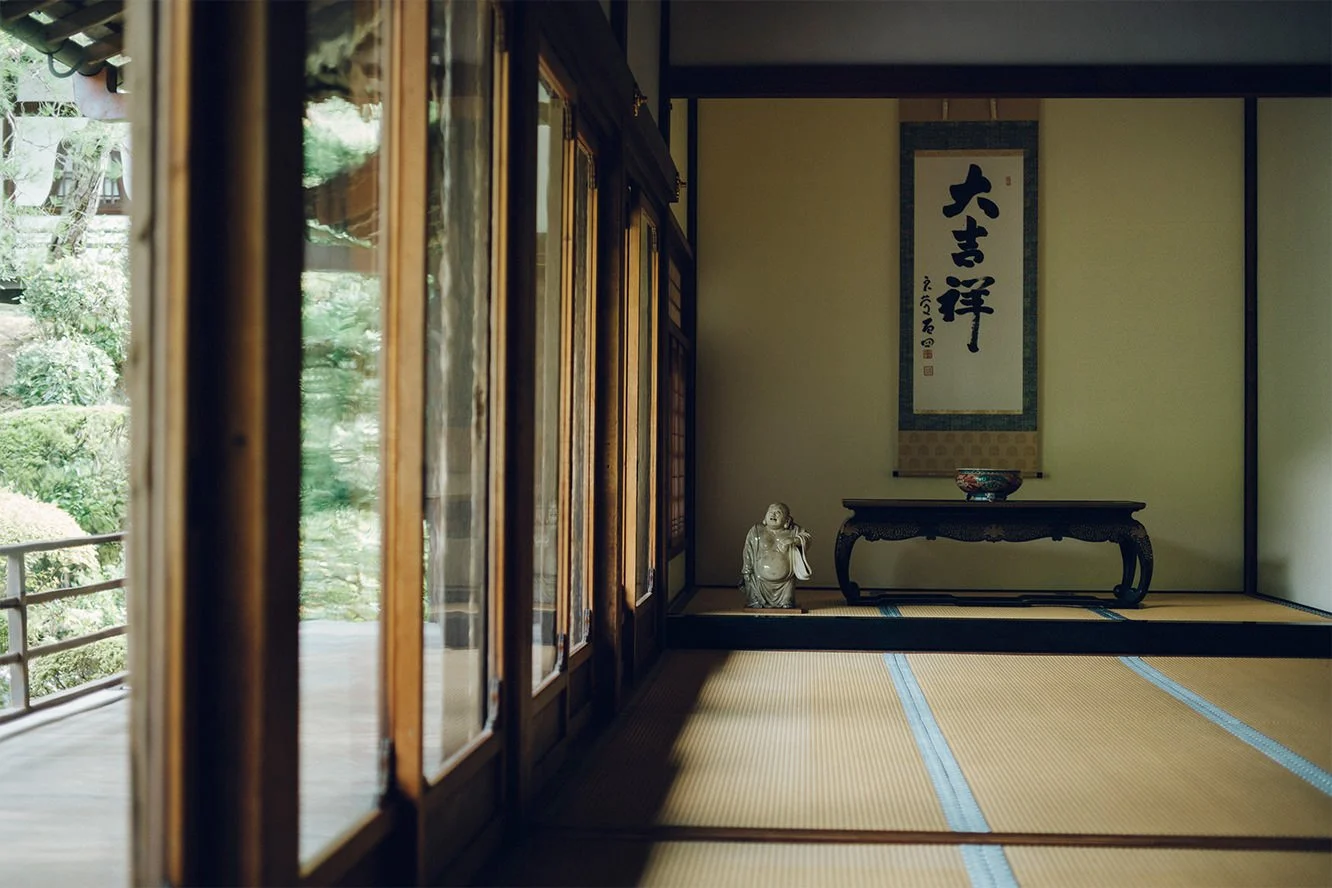
Article ● Critical Judgement
Japanese Gardens
Words by Bob Sastrowiardjo
●
Pictures by unknown
●
Pictures by unknown
The traditional Japanese gardens reflect a rich history of culture, religion, and ceremonies. This is not only through physically uses of materials, compositions, and use of surrounding landscapes, but also through symbolism and personal experiences.
For a common person lacking knowledge on the history Japanese gardens bring forth, these places ought to be ordinary lush and fluffy greenery, surrounding a pond. Some ponds are filled with Koi fish, or water lilies, others may fill the surroundings with sounds of lapping water of small cascades or springs. Water from small cascades is naturally guided by big or stacked rocks. These boulders are often found in solitude or in groups of three or four, however, smaller rocks or gravel are for larger surfaces, creating boundaries or highlighting an area.
One can find these garden characteristics when looking at the Jojuin garden also known as ‘the garden of the moon’, a traditional Japanese garden in Kyoto (Special viewing of the Jojuin garden, Kiyomizu-dera temple, n.d.). The garden is part of a Buddhistic holy ground dedicated to Kannon, the bodhisattva of compassion, which is a deity in Japanese Buddhism (Japan, Heian Period (794–1185), the Metropolitan Museum of Art, n.d.).
The temples of Kiyomizu-dera are located in Kyoto, which is close to lake Biwa and to the North of the city Osaka. It is believed that the garden dates back to the 17th century, which is significantly later than the main hall. Which was built during the Nara era in Japan (710 – 794) (The Influence of Zen on Contemporary Aesthetics in Decorative Arts and Interior Design - ProQuest, n.d.). This era was known for its high development in Buddhism and the imperial government, as the name suggests, was located in Nara.
From Paradise To Zen
During the 17th century, Buddhism was already well established in every social stratum. The teachings of the Buddha were shared at the earliest of the 6th century (A.D. 538). The ruler of a Korean kingdom, called Baekje, presented scripture rolls and ornaments to the Japanese Emperor Kimmei. The emperor believed Buddhism could enrich the Japanese culture as the teachings offered deeper moral and intellectual benefits, such as a clear set of ethical guidelines and philosophical depth, in which the nature of reality, consciousness and the self is explored. The indigenous religion of Shinto, which emphasis living in harmony with nature and spirits (kami), (animism), was less favoured, as it lacked deeper cultural teachings.
At the time Japan did not have a formal written language, which made the Chinese-inscribed Buddhist scriptures only available to the court families. During this era, the Heian era (794-1185), gardens were lush reflections of Buddhist visions of paradise. Families of the imperial court enjoyed the beauty of these gardens on boats, drifting through ponds. However, during the Kamakura era (1185-1333), ruling power shifted towards the samurai-warrior class and Zen Buddhism was introduced to Japan. Zen was quickly adopted by samurai warriors, as they identified strongly with teachings of simplicity, self-discipline, and the importance of meditation to find one’s true self, ridding themselves of worldly possessions and illusions.
Some devoted samurai warriors engaged in, and were masters, of different Zen-arts. The art of tea ceremonies, landscape gardening, Ikebana (flower arrangement), and even sweeping the garden or chopping vegetables all contributed to their practice of Zen discipline. This training aimed at focussing, and spiritually awaken the mind. One of these devoted samurai warriors, was Kobori Enshū.
It cannot be verified; however, it is believed that Kobori Enshū is one of the designers of the Jojuin garden. Enshū was most notably known as a tea master, garden designer and architect. Due to his contacts with the imperial government, Enshū got commissioned to build and reconstruct multiple temples and palaces. Some of which are Emperor-Yōzei’s palace, the Nagoya castle, and the Osaka castle in 1620. These commissions were obtained by Enshū as he was believed to be very skilful in the art of tea ceremonies.
Tea ceremonies are said to be an important ritual for cultural and political elites to discuss matters (“The Social Significance of the Japanese Tea Ceremony,” 2001). As the Japanese tea ceremony has its roots in Zen Buddhism, ceremonies have four guiding principles: wa (harmony), kei (respect), sei (purity) and jaku(tranquillity). The rituals of the formal tea ceremony, as I quote, ‘Allow participants to become so relaxed that they are at one with their surroundings.’ (“The Social Significance of the Japanese Tea Ceremony,” 2001). This zen state was most optimal for the elite to discuss and decide cultural and political matters.
These ceremonies were mostly held in a teahouse, which was dislodged from the main house. This meant guests and host needed to move through the garden, resulting in a Japanese gardening style, also known as the tea garden or Chaniwa garden. These gardens incorporated small bridges or steppingstones over water to establish the feeling of entering a different place or setting. Because most of Japan’s citizens were practitioners of the spiritual philosophy of Zen Buddhism, as can be exercised through tea ceremonies, many gardens were designed to help create a space in which one could meditate and achieve that which Buddha himself wanted to reach, enlightenment.
Tea ceremonies are said to be an important ritual for cultural and political elites to discuss matters (“The Social Significance of the Japanese Tea Ceremony,” 2001). As the Japanese tea ceremony has its roots in Zen Buddhism, ceremonies have four guiding principles: wa (harmony), kei (respect), sei (purity) and jaku(tranquillity). The rituals of the formal tea ceremony, as I quote, ‘Allow participants to become so relaxed that they are at one with their surroundings.’ (“The Social Significance of the Japanese Tea Ceremony,” 2001). This zen state was most optimal for the elite to discuss and decide cultural and political matters.
These ceremonies were mostly held in a teahouse, which was dislodged from the main house. This meant guests and host needed to move through the garden, resulting in a Japanese gardening style, also known as the tea garden or Chaniwa garden. These gardens incorporated small bridges or steppingstones over water to establish the feeling of entering a different place or setting. Because most of Japan’s citizens were practitioners of the spiritual philosophy of Zen Buddhism, as can be exercised through tea ceremonies, many gardens were designed to help create a space in which one could meditate and achieve that which Buddha himself wanted to reach, enlightenment.





